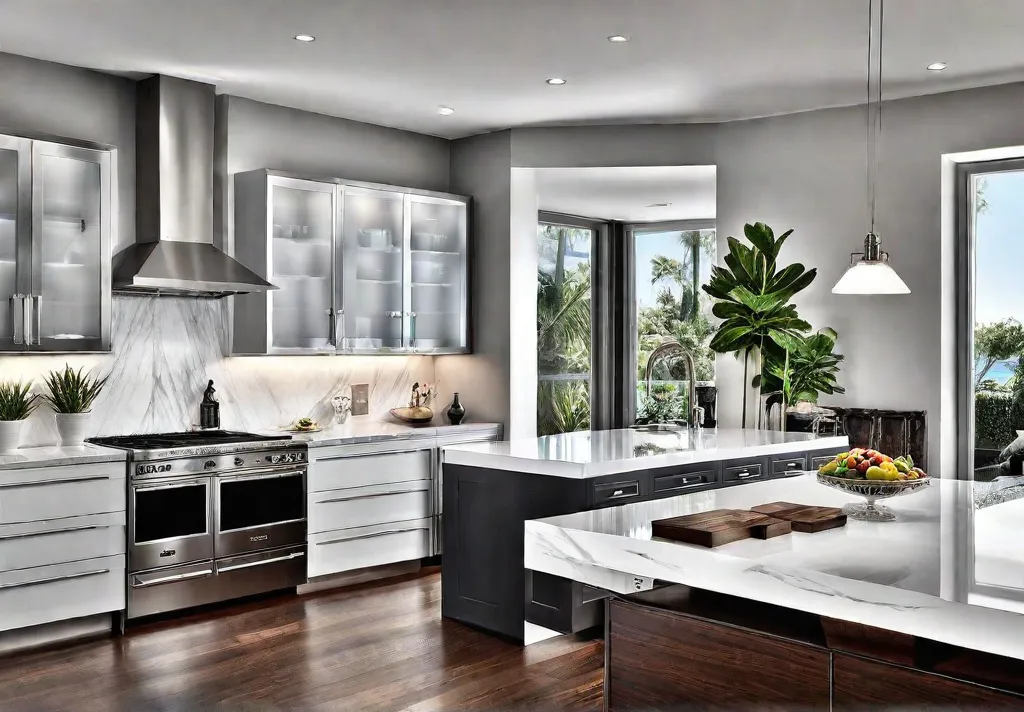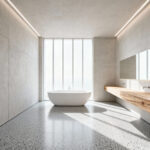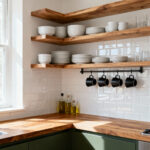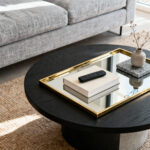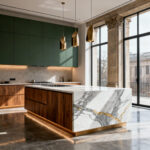Kitchens have evolved from mere cooking spaces into the heart of our homes – vibrant hubs where families gather, friends connect, and life unfolds. And when it comes to creating a modern and functional kitchen haven, the floor plays a crucial role.
Picture this: you’re standing in your dream kitchen, the sun streaming in through the windows, the aroma of a freshly baked pie wafting through the air. As you take it all in, your eyes are drawn to the floor beneath your feet. What kind of flooring would make this space truly shine?
This article explores 12 stunning kitchen flooring ideas that can transform your cooking space into a true modern haven. From the timeless charm of hardwood to the sleek sophistication of concrete, we’ve got you covered. So, please grab a cup of coffee (or tea!), and let’s dive in.
Hardwood Flooring
Hardwood flooring has long been a popular choice for kitchens, and it’s not hard to see why. This natural material offers a warm, inviting look that complements a wide range of kitchen styles, from traditional to contemporary.
One of the key benefits of hardwood is its durability. These floors can withstand heavy foot traffic and everyday wear and tear, making them a practical option for busy kitchens. Additionally, hardwood floors can increase the value of your home, as they are one of the top three most desired features for homebuyers.
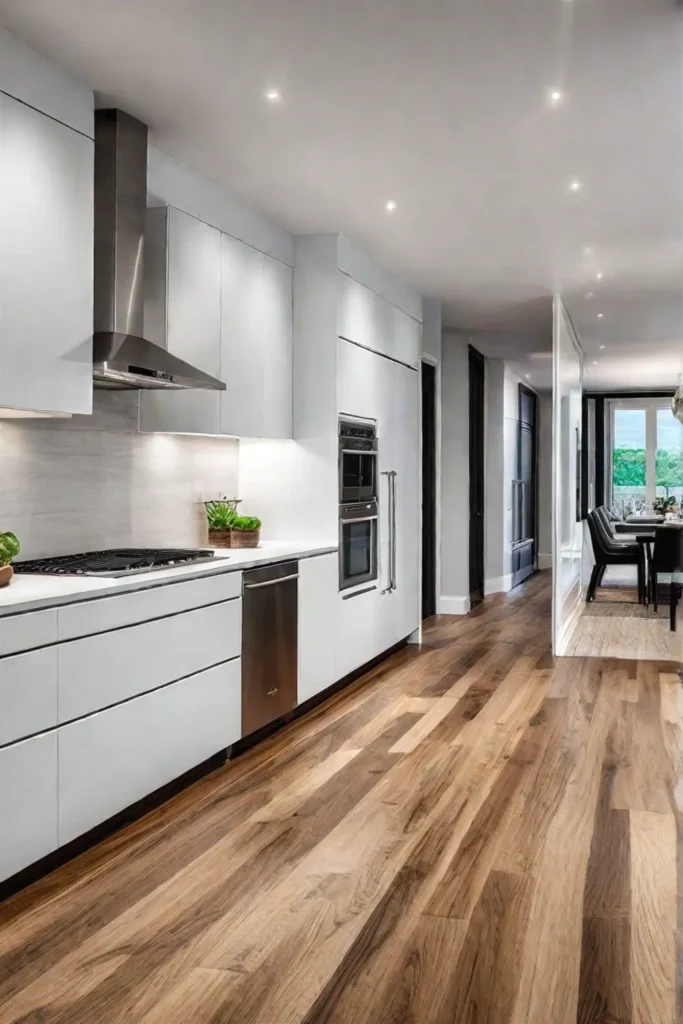
However, when installing hardwood in the kitchen, it’s important to consider the potential for water damage. Proper sealing and finishing are crucial to prevent issues like warping or discoloration. Some of the most popular hardwood species for kitchens include oak, maple, and cherry, each offering its unique charm.
To maintain your hardwood floors, it is recommended that you regularly sweep and damp mop with a hardwood cleaner. Avoid harsh chemicals or abrasive materials, as they can damage the finish. With the right care and attention, your hardwood kitchen floors can remain a stunning and timeless feature for years.
Tile Flooring
If you’re looking for a durable and water-resistant option for your kitchen floors, tile could be the way to go. Tile flooring offers a wide range of design possibilities, from traditional to modern, and comes in ceramic, porcelain, and natural stone.
One of the key advantages of tile is its longevity. With proper care, tile floors can last for decades, making them a practical choice for high-traffic areas like the kitchen. Additionally, tile is highly water-resistant, a crucial consideration in a space where spills and splashes are common.
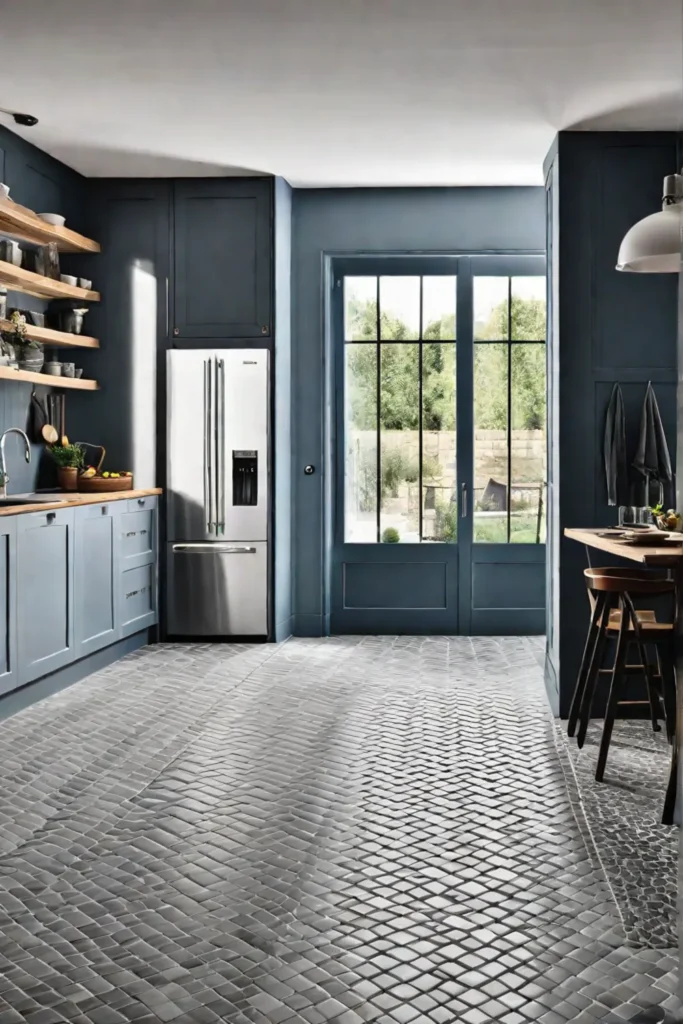
When selecting tile for your kitchen, consider slip resistance. Certain tile types, such as porcelain, have a more textured surface that can help prevent slips and falls. Additionally, the size and pattern of the tiles and the color of the grout can significantly impact the overall look and feel of your kitchen.
Regular cleaning with a damp mop and a mild detergent is recommended to keep your tile floors looking their best. Periodic sealing and regrouting can also help maintain the integrity of the surface over time.
Luxury Vinyl Plank (LVP) Flooring
Luxury vinyl plank (LVP) flooring has gained popularity in recent years, and it’s easy to see why. This versatile option offers the look of hardwood or tile with the added benefits of water resistance and durability.
One of the standout features of LVP is its waterproof construction, making it ideal for kitchens where spills and splashes are common. Additionally, LVP is highly scratch-resistant, ensuring that your floors maintain their pristine appearance even with heavy foot traffic.
Another advantage of LVP is its ease of installation. Many LVP products feature a click-and-lock system, allowing for a quick and hassle-free DIY installation process. This can be a game-changer for homeowners who want to update their kitchen floors without the added cost of professional installation.
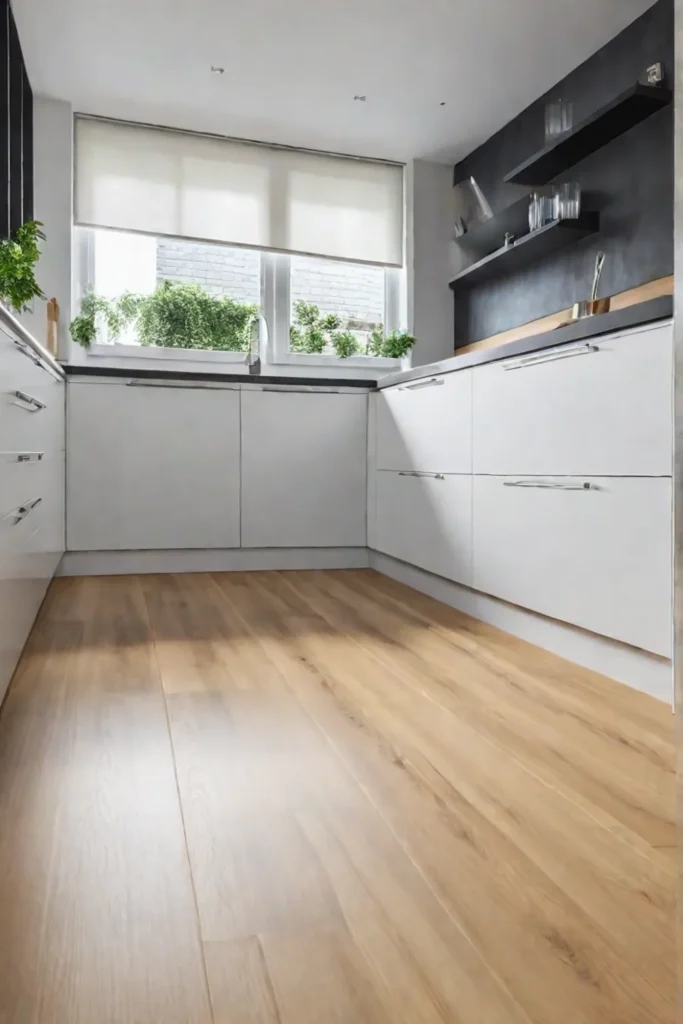
Regarding design, LVP offers a wide range of styles and textures, from sleek and modern to warm and rustic. Whether you’re going for a geometric pattern or a wood-inspired look, an LVP option suits your kitchen’s aesthetic.
To keep your LVP floors looking their best, regular sweeping and damp mopping with a mild cleaner should do the trick. Avoid harsh chemicals or abrasive tools, as they can damage the surface.
Laminate Flooring
If you’re looking for a budget-friendly option that still delivers a stylish and durable kitchen floor, laminate flooring might be the way to go. This affordable alternative can mimic the appearance of hardwood, tile, or stone while offering added water and scratch resistance.
One of the key advantages of laminate is its versatility. With a wide range of patterns and colors, you can easily find a laminate option that complements your kitchen’s design. And thanks to its water-resistant properties, laminate can be a practical choice for busy kitchens where spills and splashes are common.
Another benefit of laminate is its easy installation. Unlike other flooring options, laminate can often be installed over existing floors, saving you the time and expense of removal. Follow the manufacturer’s instructions carefully to ensure a proper and long-lasting installation.
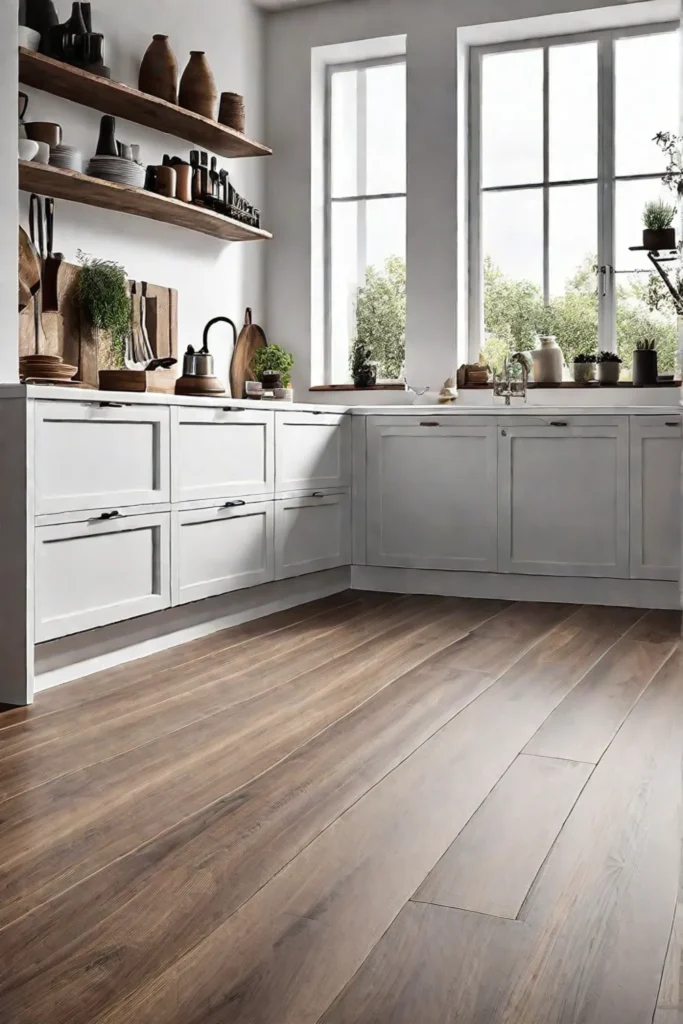
Regular sweeping and damp mopping with a gentle cleaner should be sufficient to maintain your laminate floors. Avoid harsh chemicals or abrasive tools, as they can damage the surface over time.
While laminate is a durable and practical choice, its lifespan may not match that of solid hardwood or natural stone. However, your laminate kitchen floors can still provide years of reliable service with proper care and maintenance.
Concrete Flooring
Consider concrete flooring for a truly unique and industrial-inspired look in your kitchen. This durable option offers a modern and minimalist aesthetic that can be customized to suit a range of design styles.
One of the standout features of concrete floors is their incredible strength and resilience. Concrete is known for its ability to withstand heavy foot traffic and resist wear and tear, making it an excellent choice for high-traffic areas like the kitchen.
Another advantage of concrete flooring is its easy maintenance. With regular sweeping and the occasional damp mopping, you can keep your concrete floors looking their best for years to come. And if you’re feeling creative, you can even explore options like polishing, staining, or painting the concrete to achieve your desired look.
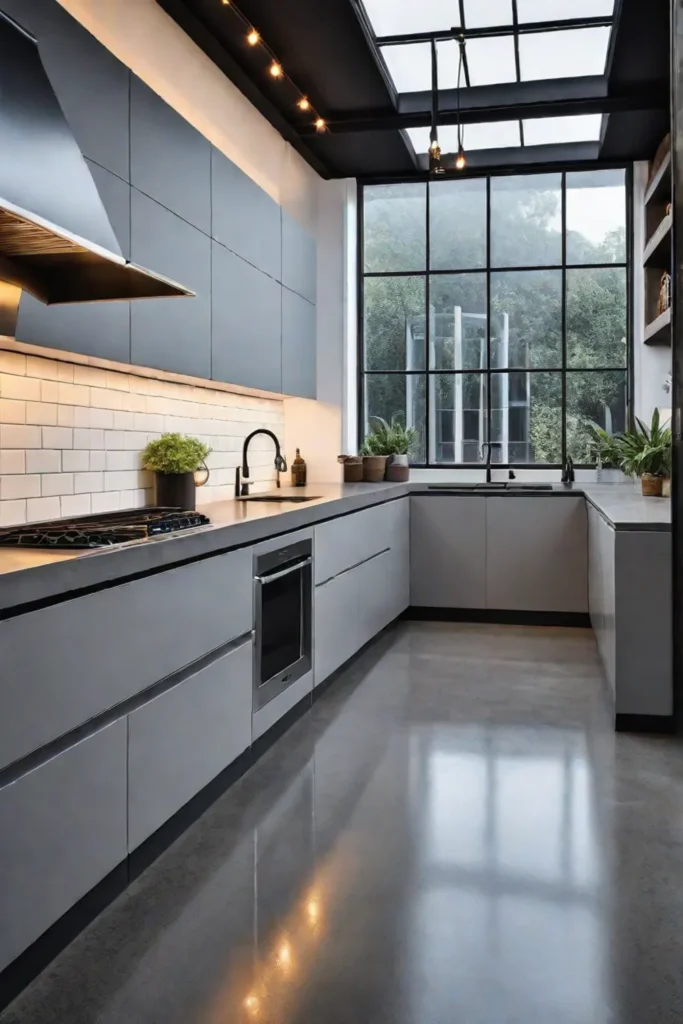
However, it’s important to note that concrete floors can feel cold and hard underfoot, which may not be the most comfortable option for those who spend much time in the kitchen. To combat this, consider investing in anti-fatigue mats or layering area rugs in key work zones.
When it comes to cost, concrete flooring can be a mid-range option, typically costing between $10 and $20 per square foot for professional installation. While this may be higher than other choices, concrete’s long-term durability and low maintenance requirements can make it a worthwhile investment.
Cork Flooring
If you want to bring a cozy and sustainable touch to your kitchen, cork flooring might be your solution. This unique material offers a soft, cushiony surface that provides comfort and style.
One of the standout features of cork flooring is its inherent water resistance. Thanks to the natural properties of the cork material, these floors are less susceptible to moisture-related damage, making them a practical choice for kitchens prone to spills and splashes.
In addition to its water-resistant qualities, cork flooring boasts impressive thermal insulation properties. This means your kitchen can stay warmer during the colder months, helping to reduce energy costs and create a more comfortable environment.
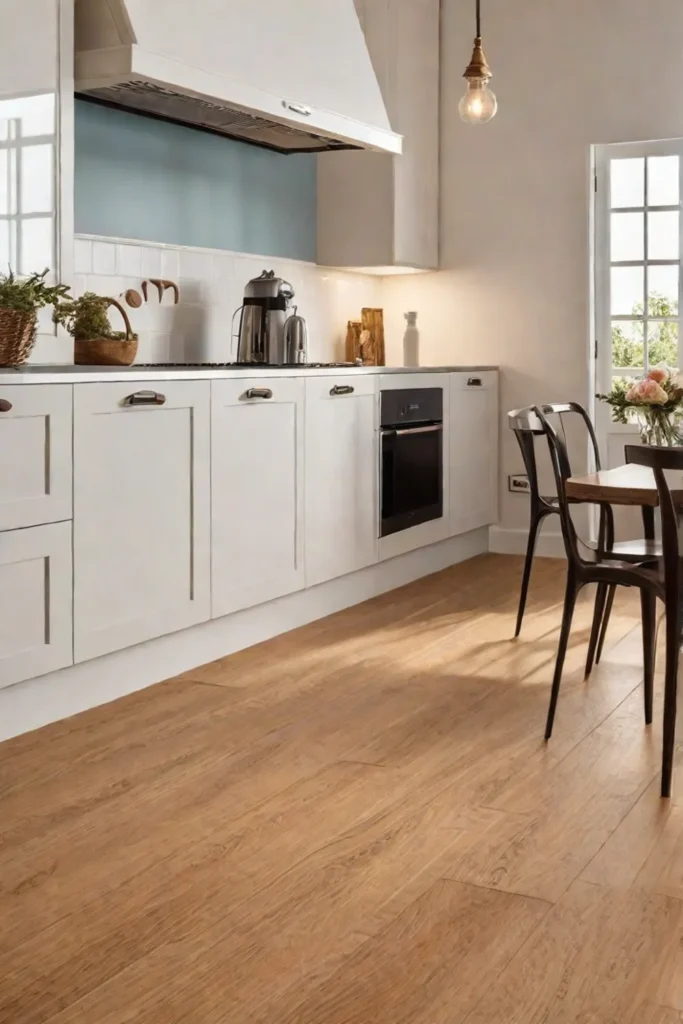
Another benefit of cork is its eco-friendly credentials. As a renewable resource harvested from the bark of oak trees, cork flooring is a sustainable option that aligns with the values of many modern homeowners.
Proper installation and regular cleaning are key to maintaining the beauty and longevity of your cork floors. Follow the manufacturer’s instructions carefully and use a damp mop with a mild detergent to keep your floors looking their best.
While cork flooring may not be as durable as some other options, its unique blend of comfort, water resistance, and sustainability makes it a compelling choice for those seeking a cozy and environmentally friendly kitchen haven.
Bamboo Flooring
Bamboo flooring is another eco-friendly option that can bring a modern and natural look to your kitchen. As a rapidly renewable resource, bamboo is a highly sustainable material with impressive durability and water resistance.
One of the standout features of bamboo flooring is its strength and resilience. Thanks to the unique structure of the bamboo plant, these floors can withstand heavy foot traffic and resist scratches and dents, making them a practical choice for busy kitchens.
In addition to its durability, bamboo flooring is also known for its water-resistant properties. This makes it a suitable option for kitchens where spills and splashes are common. With a wide range of stain options and finishes, you can easily find a bamboo floor that complements your kitchen’s overall aesthetic.
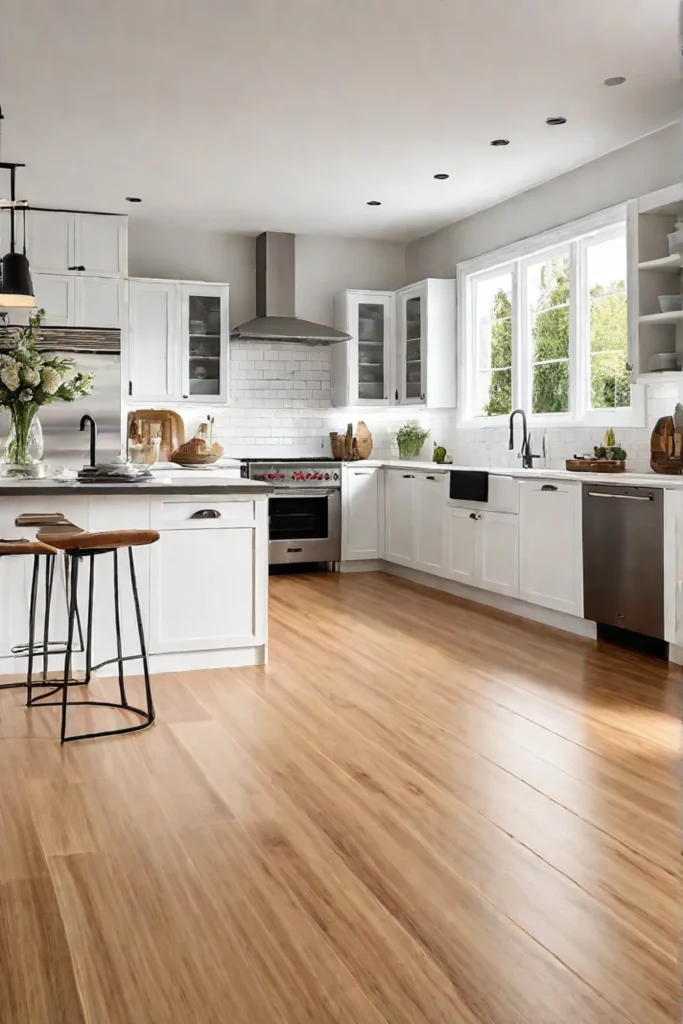
Bamboo floors can be a bit more complex to install than some other options. Proper techniques, such as gluing, nailing, or floating the floor, are crucial to ensure a long-lasting and stable installation. Be sure to follow the manufacturer’s guidelines closely to get the best results.
Maintaining your bamboo floors is relatively straightforward. The primary requirements are regular sweeping and occasional damp mopping. Avoid using harsh cleaners or abrasive tools, as they can potentially damage the surface over time.
While bamboo flooring may have a slightly higher price tag than some other kitchen flooring options, its combination of sustainability, durability, and visual appeal can make it a worthwhile investment for many homeowners.
Stone Flooring
For those seeking a truly luxurious and timeless look in their kitchen, natural stone flooring is a stunning option. From the elegant veining of marble to the rugged charm of slate, stone floors can elevate the overall aesthetic of your cooking space.
One of the key advantages of stone flooring is its exceptional durability. These natural materials are incredibly resistant to wear and tear, making them well-suited for high-traffic areas like the kitchen. Additionally, many stone options, such as granite and soapstone, offer excellent heat resistance, which can be particularly beneficial for those who frequently cook with hot pots and pans.
Regarding design, the variety of natural stone options allows you to create a truly unique and personalized look for your kitchen. Whether you opt for the classic elegance of marble, travertine’s rustic appeal, or polished concrete’s modern sophistication, stone flooring can be a true showstopper.
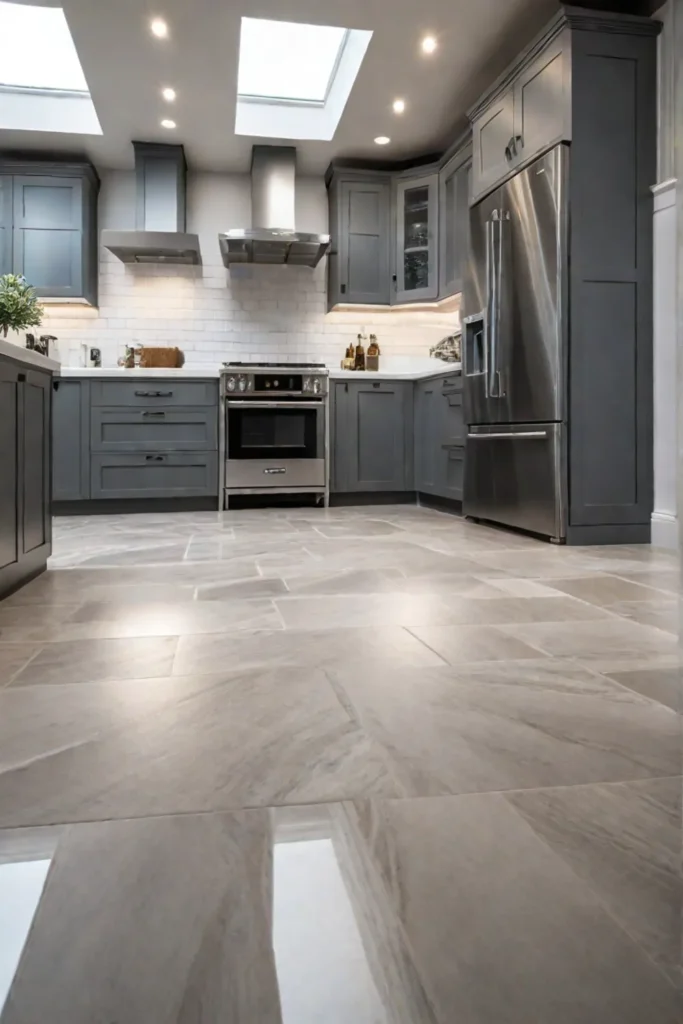
However, it’s important to note that natural stone flooring can be more expensive than other options. Additionally, certain stone types may require more maintenance, such as regular sealing and cleaning, to preserve their appearance and prevent staining or damage.
To ensure the longevity and safety of your stone floors, be mindful of choosing textured or honed finishes that provide a slip-resistant surface. Proper installation and regular cleaning with mild, stone-safe cleaners can also help maintain the beauty and integrity of your kitchen’s stone floors.
Linoleum Flooring
While it may not be the first material that comes to mind when considering modern kitchen floors, linoleum is making a comeback as a sustainable and stylish option. With its unique vintage-inspired look and durable construction, linoleum can be an excellent choice for those seeking an eco-friendly, low-maintenance flooring solution.
One of the key advantages of linoleum is its inherent water resistance and ease of maintenance. This natural material, made from linseed oil, cork, and wood flour, is highly resistant to spills and stains, making it a practical choice for busy kitchen environments.
In addition to its practical benefits, linoleum also offers a wide range of design possibilities. From classic patterns that evoke a nostalgic, retro vibe to more contemporary, minimalist designs, linoleum can create a unique and personalized look for your kitchen.
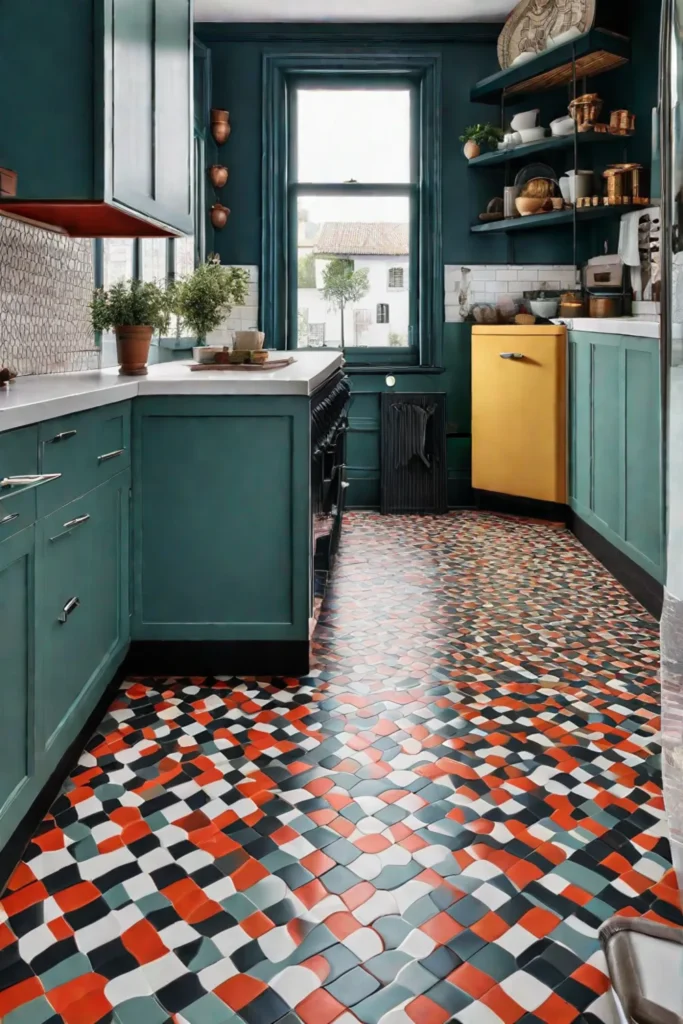
Another appealing aspect of linoleum is its eco-friendly credentials. As a renewable and biodegradable material, linoleum aligns with the sustainable values of many modern homeowners. This can be a significant selling point for those prioritizing environmental consciousness in home renovations.
Regular sweeping and damp mopping with a mild detergent solution is recommended to maintain the longevity and appearance of your linoleum floors. Avoid harsh chemicals or abrasive tools, as they can damage the surface over time.
While linoleum may not have the same long-term durability as other flooring options, its unique aesthetic, water resistance, and eco-friendly nature make it a compelling choice for those seeking a vintage-inspired yet practical kitchen floor.
Rubber Flooring
Consider rubber flooring for a modern and practical kitchen floor. This durable and slip-resistant option provides a comfortable and cushioned surface underfoot, making it ideal for those who spend a lot of time in the kitchen.
One of the standout features of rubber flooring is its exceptional durability. These floors are designed to withstand heavy foot traffic and resist scratches, dents, and other forms of wear and tear, making them a long-lasting choice for busy kitchens.
Thanks to its textured surface, rubber flooring offers excellent slip resistance in addition to its strength. This can be a crucial safety feature, especially where spills and splashes are common.
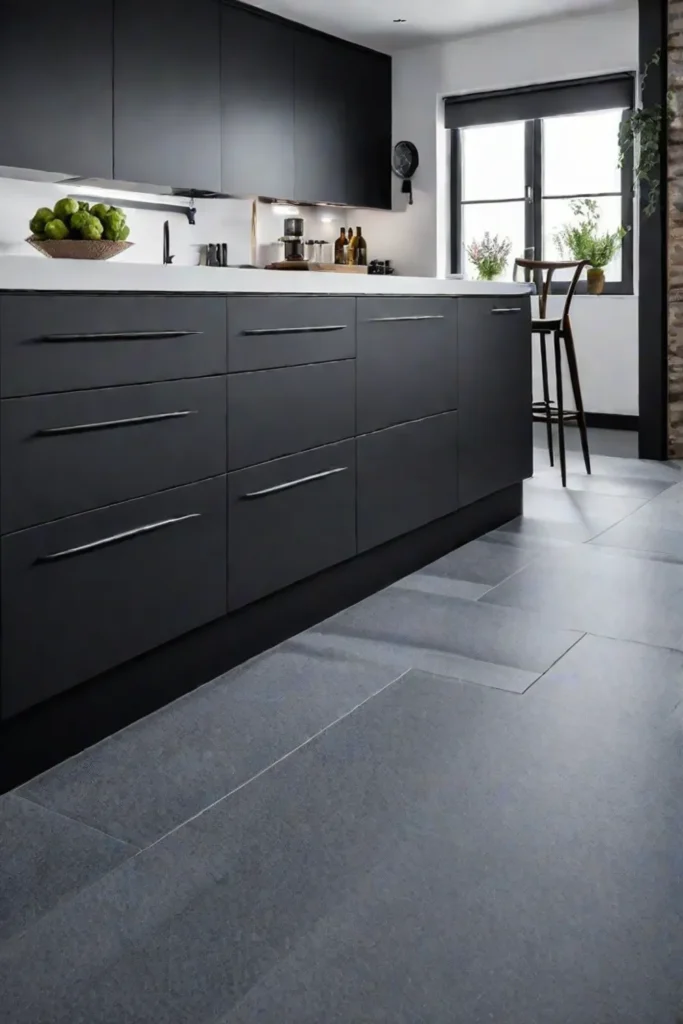
Another advantage of rubber floors is their noise-reducing properties. The cushioned surface can help absorb impact sounds, creating a quieter and more peaceful kitchen environment.
Rubber floors are relatively easy to maintain. Regular sweeping, vacuuming, or damp mopping with a mild cleaner is typically all that’s required to keep them looking their best.
While rubber flooring may not be the most budget-friendly option, its combination of durability, comfort, and safety features can make it a worthwhile investment for many homeowners. With various contemporary styles and colors available, rubber floors can be seamlessly integrated into multiple kitchen design schemes.
Mosaic Tile Flooring
If you want to add a unique and decorative touch to your kitchen, mosaic tile flooring could be the perfect solution. This eye-catching option allows you to create a truly personalized look, and you can choose from a wide range of materials, patterns, and designs.
One key advantage of mosaic tile flooring is its versatility. Whether you prefer the shimmering effect of glass tiles, the natural charm of stone, or the vibrant ceramic hues, there’s a mosaic option to suit your kitchen’s aesthetic. The intricate patterns and designs possible with mosaic tiles can serve as stunning focal points, elevating the overall look of your cooking space.
In addition to their visual appeal, mosaic tiles are also known for their durability. When properly installed and maintained, these floors can withstand heavy foot traffic and resist wear and tear, making them a practical choice for busy kitchens.
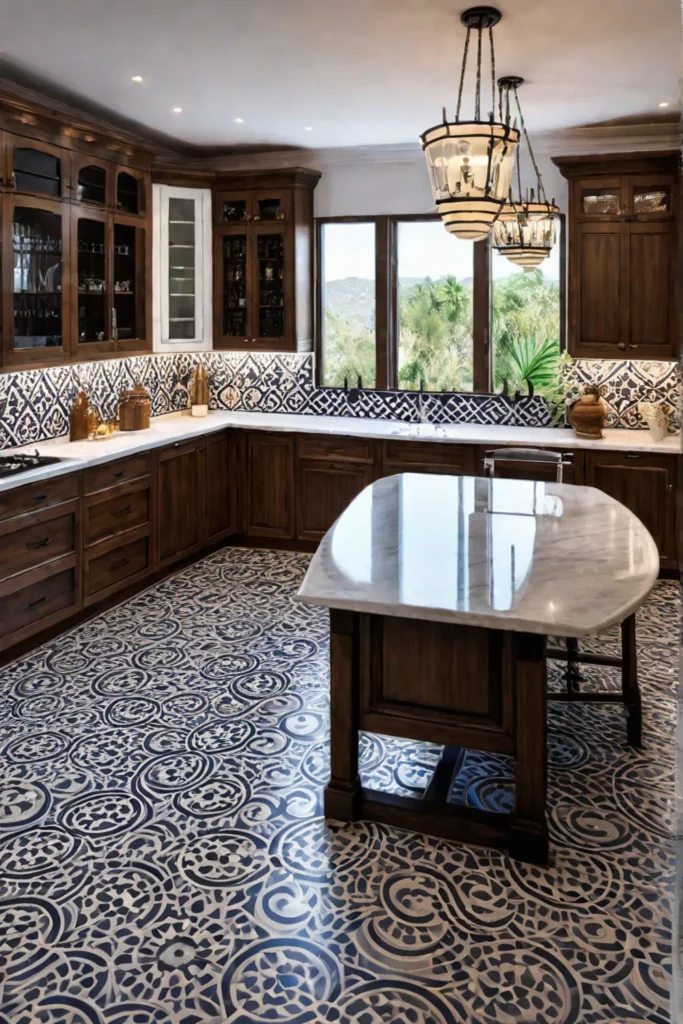
To ensure the longevity and safety of your mosaic tile floors, it’s essential to work with experienced professionals for installation. Proper adhesion, grout application, and sealing are crucial for preventing uneven surfaces or water damage over time.
While mosaic tile flooring may be more expensive than other options, the unique and personalized look it can bring to your kitchen may make it a worthwhile investment for many homeowners. By carefully considering slip resistance and maintenance requirements, you can create a stunning and functional kitchen floor that reflects your style.
Patterned or Painted Concrete Flooring
For those seeking a modern and customizable option for their kitchen floors, patterned or painted concrete can be a unique and eye-catching choice. This durable material offers endless design possibilities, allowing you to create a personalized look that sets your kitchen apart.
One of the standout features of patterned or painted concrete flooring is its exceptional strength and resilience. Concrete is renowned for its ability to withstand heavy foot traffic, spills, and other forms of wear and tear, making it an ideal choice for busy kitchen environments.
Beyond its durability, the real appeal of this flooring option lies in its customizability. You can transform a plain concrete surface into a true work of art using intricate patterns, bold colors, or even the incorporation of recycled materials. The design possibilities are virtually limitless, whether you’re going for a sleek, minimalist look or a more eclectic, industrial-inspired aesthetic.
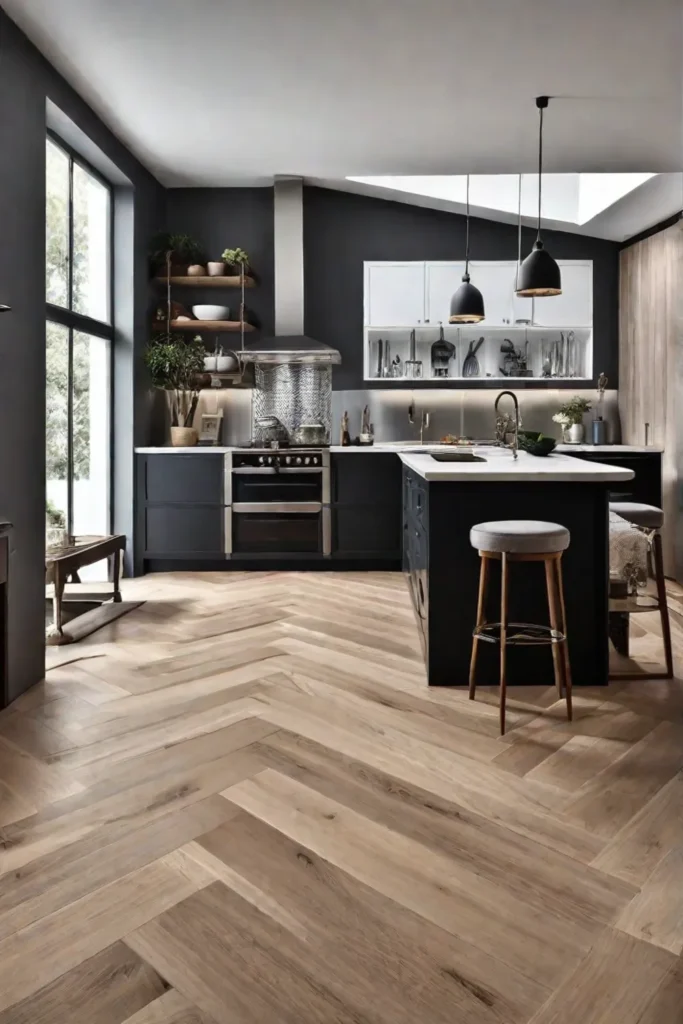
Of course, proper preparation and maintenance are key when it comes to patterned or painted concrete flooring. Ensuring a smooth, level surface before installation and using the right sealers and cleaners can help preserve the integrity and appearance of your floors over time.
While the initial cost of patterned or painted concrete may be higher than some other kitchen flooring options, the long-term durability and potential for customization can make it a worthwhile investment for many homeowners. By exploring the wide range of design possibilities, you can create a unique and stunning kitchen floor that reflects your style.
Conclusion
As we’ve explored, there is a wealth of stunning kitchen flooring ideas, each with benefits and considerations. From hardwood’s timeless charm to concrete’s modern sophistication, the options are vast and varied.
When selecting the perfect kitchen flooring for your home, you must carefully weigh factors like durability, water resistance, style, and cost to ensure you make the best choice.
